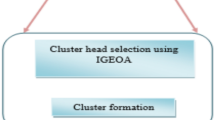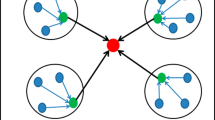Abstract
Wireless Sensor Network (WSN) consists of hundreds of devices with limited resources that collect, analyze, and transmit data to a base station. The carry-send nature and inconsistent transmission rate caused network congestion. Congestion incites decreased throughput, increased packet loss, and energy depletion. The existing congestion control strategies address congestion problems but still lack performance and quality of service issues. The optimal source transmission rate helps to alleviate congestion. The article proposes a Multi-objective Fuzzy Krill Herd Algorithm (MFKHA) control network congestion by optimizing the source sending rate. This innovative multi-objective outflow rate optimization mechanism improves network performance by designing a unique probability-based data differentiation mechanism coupled with an optimal source outflow rate optimization. To minimize network congestion by achieving fast convergence, this optimization algorithm incorporates the five objectives (congestion level, inflow rate, outflow rate, bandwidth, and queue length). To validate the performance of the proposed MFKHA algorithm, extensive simulations are carried out using MATLAB. Moreover, the proposed MFKHA algorithm is compared to those of cutting-edge meta-heuristic algorithms such as ECA-HA, ACSRO, and PSOGSA. The simulation result shows that the proposed MFKHA outperformed all counterparts and specifically improved the sending rate, throughput, and fairness and friendliness index. Furthermore, it has also reduced packet loss, delay, queue size, energy usage, and congestion against ECA-HA.
























Similar content being viewed by others
Data Availability
Data sharing not applicable to this article as no datasets were generated or analyzed during the current study.
References
Ahmed MM, Houssein EH, Hassanien AE, Taha A, Hassanien E (2019) Maximizing lifetime of large-scale wireless sensor networks using multi-objective whale optimization algorithm. Telecommun Syst 72(2):243–259. https://doi.org/10.1007/s11235-019-00559-7
Aimtongkham P, Nguyen TG, So-In C (2018) Congestion control and prediction schemes using fuzzy logic system with adaptive membership function in wireless sensor networks. Wirel Commun Mob Comput 2018:1–19. https://doi.org/10.1155/2018/6421717
Aimtongkham P, Heng S, Horkaew P, Nguyen TG, So-In C (2020) Fuzzy logic rate adjustment controls using a circuit breaker for persistent congestion in wireless sensor networks. Wireless Netw 26: 3603–3627. https://doi.org/10.1007/s11276-020-02289-0
Alaei M, Sabbagh P, Yazdanpanah F (2019) A qos-aware congestion control mechanism for wireless multimedia sensor networks. Wireless Netw 25 (7):4173–4192. https://doi.org/10.1007/s11276-018-1738-8
Alipio MI, Tiglao NMC (2018) Rt-cacc: A reliable transport with cache-aware congestion control protocol in wireless sensor networks. IEEE Trans Wireless Commun 17(7):4607–4619. https://doi.org/10.1109/TWC.2018.2827986
Almalawi A, Khan AI, Alsolami F, Abushark YB, Alfakeeh AS, Mekuriyaw WD (2022) Analysis of the exploration of security and privacy for healthcare management using artificial intelligence: Saudi hospitals. Comput Intell Neurosci 2022:1–10. https://doi.org/10.1155/2022/4048197
Amer H, Al-Kashoash H, Khami MJ, Mayfield M, Mihaylova L (2020) Non-cooperative game based congestion control for data rate optimization in vehicular ad hoc networks. Ad Hoc Netw 107:1–13. https://doi.org/10.1016/j.adhoc.2020.102181
Beitelspacher S, Mubashir M, Besher K M, Ali M Z (2020) Prioritizing health care data traffic in a congested iot cloud network. In: IEEE Wireless Communications and Networking Conference Workshops, WCNCW, IEEE. https://doi.org/10.1109/WCNCW48565.2020.9124867
Bhatti KA, Asghar S (2022) Progressive fuzzy pso-pid congestion control algorithm for wsns. Arabian Journal for Science and Engineering, https://doi.org/10.1007/s13369-022-06701-z
Bohloulzadeh A, Rajaei M (2020) A survey on congestion control protocols in wireless sensor networks. Int J Wireless Inf Networks 27:365–384. https://doi.org/10.1007/s10776-020-00479-3
Cameron J, Kaye ME, Scheme E (2020) Dynamic prioritization of surveillance video data in real-time automated detection systems. Expert Syst Appl 161:1–21. https://doi.org/10.1016/j.eswa.2020.113672
Chaturvedi S, Pragya P, Verma HK (2015) Comparative analysis of particle swarm optimization, genetic algorithm and krill herd algorithm. In: 2015 International Conference on Computer, Communication and Control (IC4), pp 1–7, https://doi.org/10.1109/IC4.2015.7375552
Daanoune I, Baghdad A, Balllouk A (2019) A comparative study between aco-based protocols and pso-based protocols in wsn. In: The 7th Mediterranean Congress of Telecommunications (CMT), pp 1–4, https://doi.org/10.1109/CMT.2019.8931320
Dev K, Maddikunta PKR, Gadekallu TR, Bhattacharya S, Hegde P, Singh S (2022) Energy optimization for green communication in iot using harris hawks optimization. IEEE Transactions on Green Communications and Networking 6(2):685–694. https://doi.org/10.1109/TGCN.2022.3143991
Fei Z, Li B, Yang S, **ng C, Chen H, Hanzo L (2016) A survey of multi-objective optimization in wireless sensor networks: Metrics, algorithms, and open problems. IEEE Communications Surveys and Tutorials 19(1):550–586. https://doi.org/10.1109/COMST.2016.2610578
Grover A, Kumar RM, Angurala M, Singh M, Sheetal A, Maheswar R (2022) Rate aware congestion control mechanism for wireless sensor networks. Alex Eng J 61(6):4765–4777. https://doi.org/10.1016/j.aej.2021.10.032
Hamidouche R, Aliouat Z, Ari AAA, Gueroui M (2019) An efficient clustering strategy avoiding buffer overflow in iot sensors: a bio-inspired based approach. IEEE Access 7:156733–156751. https://doi.org/10.1109/ACCESS.2019.2943546
Khan AI, Alghamdi ASAM, Alsolami FJ, Abushark YB, Almalawi A, Ali AM, Agrawal A, Kumar R, Khan RA (2022a) Integrating blockchain technology into healthcare through an intelligent computing technique. Computers, Materials and Continua 70(2):2835–2860. https://doi.org/10.32604/cmc.2022.020342
Khan AI, Alsolami F, Alqurashi F, Abushark YB, Sarker IH (2022b) Novel energy management scheme in iot enabled smart irrigation system using optimized intelligence methods. Eng Appl Artif Intell 114:104996
Lin L, Shi Y, Chen J, Ali S (2020) A novel fuzzy pid congestion control model based on cuckoo search in wsns. Sensors 20(7):1–16. https://doi.org/10.3390/s20071862
Ma C (2018) A congestion control protocol for wireless sensor networks. In: International Conference on Computational Social Networks, Springer, pp 356–367, https://doi.org/10.1007/978-3-030-04648-4_30
Maddikunta PKR, Gadekallu TR, Kaluri R, Srivastava G, Parizi RM, Khan MS (2020) Green communication in iot networks using a hybrid optimization algorithm. Comput Commun 159:97–107 . https://doi.org/10.1016/j.comcom.2020.05.020. https://www.sciencedirect.com/science/article/pii/S0140366420301286
Mansouri N, Zade BMH, Javidi MM (2020) A multi-objective optimized replication using fuzzy based self-defense algorithm for cloud computing. J Netw Comput Appl 171:1–33. https://doi.org/10.1016/j.jnca.2020.102811
Narawade V, Kolekar UD (2018) Acsro: Adaptive cuckoo search based rate adjustment for optimized congestion avoidance and control in wireless sensor networks. Alex Eng J 57(1):131–145. https://doi.org/10.1016/j.aej.2016.10.005
Nikokheslat HD, Ghaffari A (2017) Protocol for controlling congestion in wireless sensor networks. Wireless Pers Commun 95(3):3233–3251. https://doi.org/DOI10.1007/s11277-017-3992-y
Parsa A, Moghim N (2021) Qos-aware routing and traffic management in multi-flow opportunistic routing. Computers & Electrical Engineering 94:1–14. https://doi.org/10.1016/j.compeleceng.2021.107330
Qu S, Zhao L, **ong Z (2020) Cross-layer congestion control of wireless sensor networks based on fuzzy sliding mode control. Neural Comput Appl 32:13505–13520. https://doi.org/10.1007/s00521-020-04758-1
Qureshi IA, Asghar S (2021) A genetic fuzzy contention window optimization approach for IEEE 802.11 WLANS. Wireless Netw 27(4):2323–2336. https://doi.org/10.1007/s11276-021-02572-8
Rezaee AA, Pasandideh F (2018) A fuzzy congestion control protocol based on active queue management in wireless sensor networks with medical applications. Wireless Pers Commun 98(1):815–842. https://doi.org/10.1007/s11277-017-4896-6
Sarker IH, Khan AI, Abushark YB, Alsolami F (2022) Internet of things (iot) security intelligence: A comprehensive overview, machine learning solutions and research directions. Mobile Networks and Applications, https://doi.org/10.1007/s11036-022-01937-3
Shah SA, Nazir B, Khan IA (2017) Congestion control algorithms in wireless sensor networks: Trends and opportunities. J King Saud Univ Comput Inform Sci 29(3):236–245. https://doi.org/10.1016/j.jksuci.2015.12.005
Shelke MP, Malhotra A, Mahalle P (2017) A packet priority intimation-based data transmission for congestion free traffic management in wireless sensor networks. Comput Electr Eng 64:248–261. https://doi.org/10.1016/j.compeleceng.2017.03.007
Singh K, Singh K, Son LH, Aziz A (2018) Congestion control in wireless sensor networks by hybrid multi-objective optimization algorithm. Comput Netw 138:90–107. https://doi.org/10.1016/j.comnet.2018.03.023
Srivastava V, Tripathi S, Singh K, Son LH (2020) Energy efficient optimized rate based congestion control routing in wireless sensor network. J Ambient Intell Humaniz Comput 11:1325–1338. https://doi.org/10.1007/s12652-019-01449-1
Vijayalakshmi K, Anandan P (2019) A multi objective tabu particle swarm optimization for effective cluster head selection in wsn. Cluster Computing 22(5):12275–12282. https://doi.org/10.1007/s10586-017-1608-7
Wang GG, Gandomi AH, Alavi AH, Gong D (2017) A comprehensive review of krill herd algorithm: variants, hybrids and applications. Artif Intell Rev 51(1):119–148. https://doi.org/10.1007/s10462-017-9559-1
Yadav SL, Ujjwal RL, Kumar S, Kaiwartya O, Kumar M, Kashyap PK (2021) Traffic and energy aware optimization for congestion control in next generation wireless sensor networks. J Sensors 2021:5575802. https://doi.org/10.1155/2021/5575802
Yang X, Chen X, **a R, Qian Z (2018) Wireless sensor network congestion control based on standard particle swarm optimization and single neuron pid. Sensors 18(4):1265. https://doi.org/doi:10.3390/s18041265
Yannibelli V, Pacini E, Monge D, Mateos C, Rodriguez G (2020) A comparative analysis of nsga-ii and nsga-iii for autoscaling parameter sweep experiments in the cloud. Scientific Programming 2020, https://doi.org/10.1155/2020/4653204
Author information
Authors and Affiliations
Corresponding author
Ethics declarations
This article does not contain any studies with human participants or animals performed by any of the authors.
Conflict of interests
Authors declare that they have no conflict of interest.
Additional information
Publisher’s note
Springer Nature remains neutral with regard to jurisdictional claims in published maps and institutional affiliations.
Rights and permissions
Springer Nature or its licensor (e.g. a society or other partner) holds exclusive rights to this article under a publishing agreement with the author(s) or other rightsholder(s); author self-archiving of the accepted manuscript version of this article is solely governed by the terms of such publishing agreement and applicable law.
About this article
Cite this article
Bhatti, K.A., Asghar, S. & Naz, S. Multi-objective fuzzy krill herd congestion control algorithm for WSN. Multimed Tools Appl 83, 2093–2121 (2024). https://doi.org/10.1007/s11042-023-15200-8
Received:
Revised:
Accepted:
Published:
Issue Date:
DOI: https://doi.org/10.1007/s11042-023-15200-8




